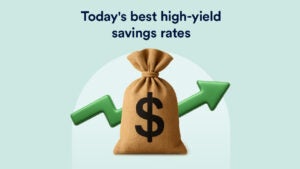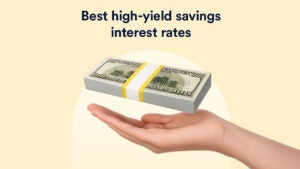What is a good interest rate on a savings account?

Key takeaways
- The best high-yield savings accounts currently earn APYs up to 4.35%, over seven times higher than the national average.
- Current inflation sits at 2.7% annually, so top savings rates are beating inflation by over 1.5 percentage points.
- The federal funds rate remains at 4.25%-4.50%, keeping high-yield savings rates elevated for savers.
A high-yield savings account earning over 4 percent APY is an excellent place to grow your money safely — while also offering easy access to funds. The best rates currently range from around 4 percent up to 4.35 percent APY at top online banks and credit unions.
These rates are significantly higher than traditional savings accounts, which typically earn just 0.01% to 0.10% APY at major brick-and-mortar banks. When your money earns a rate that outpaces inflation, your purchasing power actually grows over time.
What is a good savings account interest rate?
Today’s best high-yield savings accounts are earning APYs of around 4.25 percent, with some accounts still offering rates near 5 percent. This compares to a national average of just 0.62 percent APY, according to Bankrate data.
“We’re in a unique environment where savings rates are still outpacing inflation. The Federal Reserve has kept rates elevated through 2025, but with economic uncertainty, savers should take advantage of these historically high rates while they’re available.”— Greg McBride, CFA, Bankrate Chief Financial Analyst
How much can you earn with today’s rates?
Here’s what various amounts would earn in one year at a 4.25% APY:
- $1,000: $42.50
- $5,000: $212.50
- $10,000: $425
- $25,000: $1,062.50
- $50,000: $2,125
Where to find the best savings account interest rates
You can typically find the highest APYs at the following institutions:
- Online banks: Most competitive rates due to lower overhead costs
- Credit unions: Often offer rates comparable to online banks with additional member benefits
- Digital-first institutions: Newer fintech companies frequently offer promotional rates
Ready to maximize your savings? See Bankrate’s complete list of the best online banks and credit unions with current rates, minimum balance requirements, and key features.
High-yield savings accounts vs. other options
When to choose a high-yield savings account
-
Emergency funds: The perfect place for 3-6 months of expenses where you need both growth and accessibility.
-
Short-term goals: Saving for a vacation, wedding, or home down payment within the next 2-3 years.
-
Cash reserves: Money you want to earn interest on while staying completely liquid.
Bottom line
The current rate environment offers an exceptional opportunity to grow your savings safely. While rates may not stay this high indefinitely, today’s savers can take advantage of returns that both preserve and grow purchasing power.
Ready to start earning more on your savings? Check out our guide to picking the right savings account for you.
Why we ask for feedback Your feedback helps us improve our content and services. It takes less than a minute to complete.
Your responses are anonymous and will only be used for improving our website.






